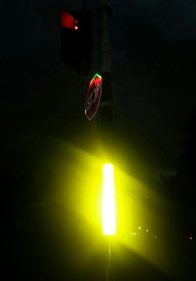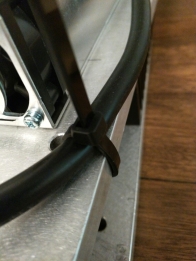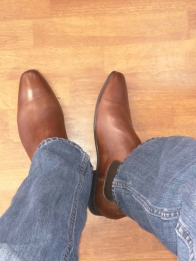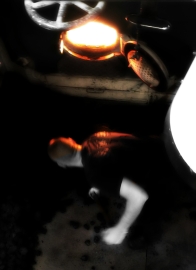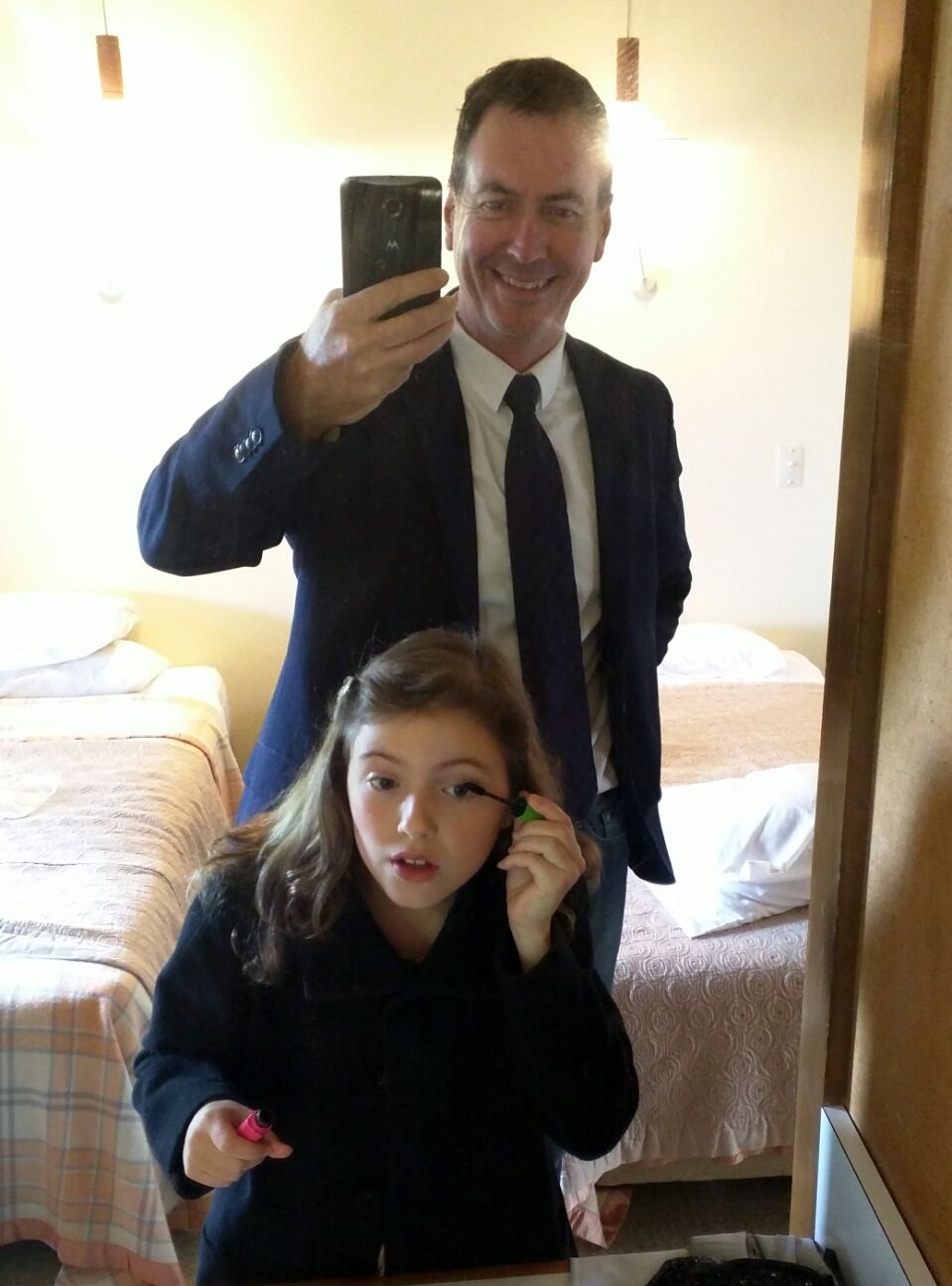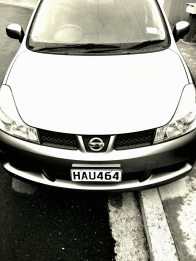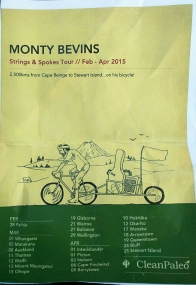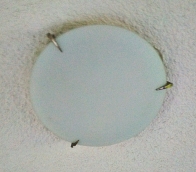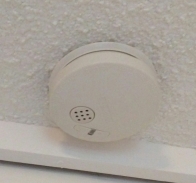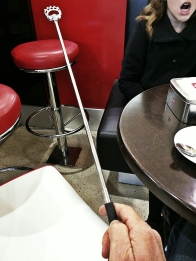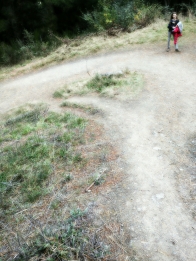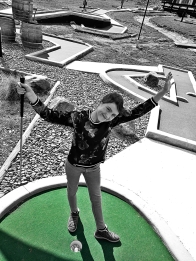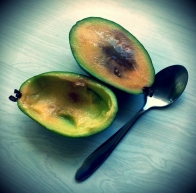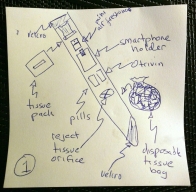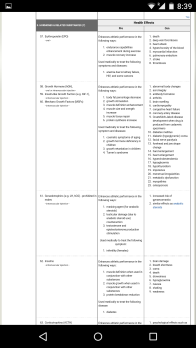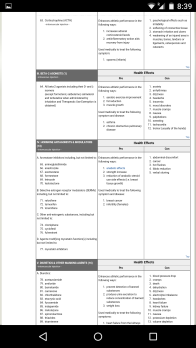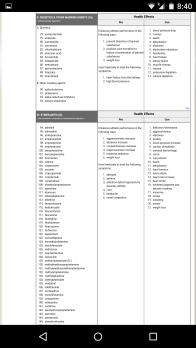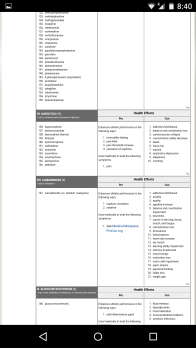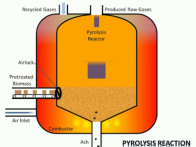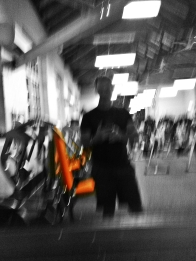Apparently I don’t have normal sized feet.
Monthly Archives: April 2015
Cognitives explained
Ever heard of cognitive consonance? Getting some cognitive dissonance right now?
Developed by music-loving psychologists, the cognitive dissonance around the lack of cognitive consonance in psychology can be understood thus …
Wiki informs us that “In music, consonance and dissonance form a structural dichotomy in which the terms define each other by mutual exclusion: a consonance is what is not dissonant … consonance and dissonance define a level of sweetness / harshness, pleasantness / unpleasantness, acceptability / unacceptability, of the sounds or intervals under consideration … the two concepts have never been completely explained, and for a thousand years the definitions have varied.”
That is, one person’s cognitive dissonance might just be another’s cognitive consonance.
In any case, the reason you’ve never heard of cognitive consonance is that there’s no money in it.
Having got that off my cognitive chest I can now rest with the cognitive assurance that I have cognitive assonance to match my cognitive insouciance.
GCL
IP does not have an address
I suspect that many people are fooled by the title “intellectual property.”
It would be better labeled as “creative derivatives.”
Neither title really means anything but over time the latter term might come to represent something akin to reality,just as the former term currently conjures up thoughts of inventors and creatives at an intellectual house auction.
If you need to know, think of a government agency selling options to reduce risks of corporate competition, and you’d be closer to the mark.
Very creative!
Fruit Loops v Blunters
Courtesy of the Qantas I read this thing called the Saturday Paper, which appears to be a weekly that comes out only on Saturdays.
So I had a glance. My summary – the only people that would look forward to reading this tabloid are the vaguely concerned and pre-preached folk that occupy the top tiers of the tax brackets.
Oddly enough I would rather read the Daily Telegraph – at least there I will be challenged by the blunter drivel that the editor imagines his boss would like to see.
The Saturday Paper could well be described as a weekly version of The Monthly without so much arty content, and it is possibly aimed at those that claim the Sydney Morning Herald used to have better content (for a couple of weeks in the early 1980s).
The main problems with the one edition of the Saturday Paper that I have just read are (1) The issues are chestnut-central – global warming, asylum seekers, ICAC, etc, and (2) Problems are identified but not a single solution is provided. You could happily have named this paper “The Someone should do Something Times”
Here’s what I would like to see in a paper. Novelty with regards to subject matter. Solutions as well as problems. Debate and not propaganda. Challenging ideas rather than the thin green line. Context other than that of first world risk-free complacency. And finally, the universe and not just the inner burbs of Sydney and Melbourne.
Ever heard of the culture wars? Well it’s this Lilliputian battle for ascendency in Australia between the blunters and the fruit loops. Members of both warring parties are stuck in mindsets that were developed whilst at university, dreaming of pitched battles in 1970. What they want is control of the the vibe that drives policy decisions around the edges of what people really care about.
The Saturday Paper is an instrument of the fruit loops. You know who they are – very concerned people but with plenty of affluence. A quick look at the ads in the Saturday Paper gives it away – Rolex, Mercedes Benz and the Essential Bergman film festival.
This paper will not convert a soul. But it is a missive to the blunters, stating that they, the fruit loops, haven’t thrown in the towel. The blunters may have swayed the masses by aiming for the hip pocket but the fruit loops will keep the home flame burning whilst they develop their strategies to pounce the next time the budget is in surplus in a decade or two.
Life insurance
I had a beer with a life insurance actuarial expert the other day.
He was describing to me how they are using more and more data to create personalised life insurance premiums.
I suggested to him, jokingly, that they put an app on a smartphone and then use this to monitor smartwatch-measured vital signs in order to monitor health risks in real time and adjust premiums accordingly. He really loved this idea and is ‘onto it’.
I always thought insurance was about sharing the risk between groups of people. This is apparently not the case anymore; the insurance industries are determined to price insurance according to individual risk factors and only cover us for known probabilistic events.
By understanding us in detail they are entirely removing their risks of business failure.
In which case, I pointed out, people on the right hand side of the risk Bell curve may as well self insure. And then half the people on the left hand side would then be compelled to do the same, and so on.
You have to think that this is one industry that really needs disintermediating.
If there ends up being no risk then there should be no profit either.
At the very least a crowd sourced people-free version of insurance would cut out a lot of unnecessary operating costs that are passed onto us consumers.
2.7k
Foosball, nerfballs but no Tesla cars
In attempting to explain to someone why our so many of our Australian startup entrepreneurs seem so destined not to succeed I eventually reverted to stating that;
“In Australia money is a religion but in the US it’s a God.”
The data? I have met US startup founders that would sell their left arm if that would secure success.
Conversely, when I wander into any Australian startup incubator I am always struck by the clubby harmlessness of the thing.
It’s almost as though our Gen Y operatives define success by just being there.
Grey Index
My mum is worried that our government will force people to work later and later in life (by withholding the pension) but that there won’t be any jobs for older people, leading to late age poverty.
She thinks that this problem will get worse as our population ages; a result of the boom in babies during the baby boomer era, decreased birth rates of late, and continually improving medical technologies.
I suggested to mum that we develop a ‘Grey Index’ so that the products and services of companies are rated by the relative age of their employees.
You can imagine this sort of like the energy 5 star rating sticker on white-goods but where 5 stars in this instance would mean everyone in the company is over 60, and 1 star would represent a company full of teens.
All products or services would be accompanied by a grey index notice, whether that is on the web, in the window of a hairdressers, or a sticker on the side of a fridge.
Since the population is aging, companies would have to take the purchasing mass of the elderly quite seriously and promote age friendly employment. Otherwise a large fraction of the buying masses might silently boycott their products or services.
A side benefit of this idea is that it could be used to further protect Australian domestic companies from foreign competition (we love doing this). Even on the web a failure of a foreign firm, say Ebay, to publicise their grey index might lead to some sort of retaliatory action.
STEM minus IT = BS
Ponder this quote that was sent to me ….
“A lack of skills in Science, Technology, Engineering and Mathematics (STEM) in the current and emerging workforce is holding back Australia’s economy. A recent survey by AIG, which spoke to 300 businesses across the country, found nearly half were having difficulty recruiting technicians and trade workers with STEM skills.”
And then a report from PwC pops up with the same rubbish. My guess that the source of all this tripe is the GO8, the sandstone universities, looking for funding to prop up their ailing science and engineering faculties. I could be wrong; this is just a guess.
The real issue is that businesses are having trouble hiring IT workers at reasonable cost due to supply and demand pressures. They don’t mind whining about it either.
But if you subtract IT types from STEM (to get STEM minus IT) and re-asked all those businesses the question they would say ‘we hardly need any of them (science graduates, mathematicians, old school engineers) and when we do there is no issue finding them’.
This is a case of a false grouping seeking to create the illusion of a problem so that a bunch of educators can get even more money off the government.
The result? Graduates in the sciences and old-school engineering fields that study for years and end up having to get jobs outside of their fields of expertise.
We are already training way too many scientists and old school engineers and it makes no sense to double down on this problem.
Also, salaries in these areas drop as supply and demand gets unbalanced to the supply side, which puts downwards pressure on the quality of the candidates entering these fields.
We are in the digital age and the relative demand for scientists and old school engineers will continue to decline over the next few decades. IT graduates, on the other hand, we won’t be able to train enough of them.
So please stop using the false grouping, STEM!
Corporate CEO Skills
And there I was, finding myself discussing the attributes required to make a great corporate CEO.
My view, for what it’s worth is that a great CEO needs –
1. Strategy skills – ultimately the strategy decisions are the CEOs
2. Mentoring skills – building the best possible team of direct reports and motivating them
3. Rigour & Discipline – so as not be snowed by anyone and not let the guard down
4. Deep industry and company experience – outsiders struggle due to a lack of feel
5. Driven self-centeredness hidden behind a wall of geniality
In thought leadership circles this would be displayed thus …
Teen Crypto App
Lola wants a new app that automatically converts real words as typed into a phone or computer into a teen’s crypto language that she and her mates currently use to pass notes around.
I think the crypto language is used so that their notes can’t be read accidentally by the boys that are the subject of the notes.
The app would intercept the commands sent from the keyboard or touchscreen and display the crypto language in whatever messenger service they are using, which seems to be Instagram at the moment. That is, English would never be shown on the screen on the sender’s device.
It would also be received and read in crypto-babble.
Interestingly just about all encryption currently on the net encrypts a message at one end and decrypts it at the other, and hence there is a requirement for shared information (e.g. a key) between the two devices which inherently creates a security hole.
This new idea only encrypts at the sender end and there is no need to decrypt at the other end since the recipients have all memorised the decryption algorithm.
New product idea
A cable tie containing a plastic-encased metal aerial and a micro-connector at the blunt end.
By making sure the thing was rigid enough, just like the cable tie below, this new type of aerial could be easily mounted just about anywhere and you could do away with all this dodgy mounting elements that plague current aerials.
Gigatrend
My big forecast for the next Megatrend is the emergence of the Gigatrend.
Gigas are bigger than Megas mate. And Megas will be so ‘yesterday’ pretty soon.
So that first sentence should really read “my big forecast for the next Gigatrend is the Gigatrend.” But then how can you forecast something that already exists?
But on the flip side, a Gigatrend can’t be a Megatrend.
So simultaneously I have discovered a linguistic loop worthy of philosophical debate. A two-fer!
This is me practicing Thought Leadership. Just in case you’re wondering.
Thomas the Tank Engine
As few blog entries back I noted that proton lifetime was 10^25 years. It has been pointed out to me that this is 10^9 years shorter than current estimates. My bads.
Proton decay is one of the few unobserved effects of GUT (the Theory of Life, the Universe and Everything) and was a focus of major experimental physics efforts starting in the early 1980s.
To date, all attempts to observe proton decay have failed.
In my view the experimental physicists have two choices: to run their experiments for another 10^24 years or so, or, and this is the far more exciting option, build a whopping big electromagnetic train track in Switzerland somewhere and set up a collision between protons that smashes the crap out of them.
Money well spent I say.
Oxy-moron
Intellectual Property Valuation explained (once and for all)
Valuation analysts and Intellectual Property professionals apparently agree that there are four standard methodologies to value Intellectual Property (IP):
1. Cost Approach: This approach is based on the historical cost to develop an IP asset which is used to determine its value. This is pretty silly because why would anyone develop an asset that they did not expect to appreciate in value?
2. Income Approach: The income approach calculates the present value of future income streams specifically attributable to the intellectual property asset. Except in the specific case of contractually obligated income, this approach requires the use of the same crystal ball that many companies used to prepare themselves for global financial crisis.
3. Market Approach: The market approach values intellectual property by comparing an IP asset to publicly available transactions involving similar assets with similar uses. Otherwise known as benchmarking, this approach assumes that markets don’t lie. Of course another crystal ball is required to decide which companies or assets to benchmark against.
4. Relief from Royalty Approach: In this approach a hypothetical situation is created to estimate what a business would pay to license its own intellectual property assets in an arm’s-length transaction. The value is then calculated as the net present value of the so-avoided hypothetical royalty charges. And the answer is just about always whatever the CFO needs.
In addition to the traditional methods used to value intellectual property, there are at least twenty-five alternative valuation methodologies:
Brand Contribution Methodology: The contribution to IP value made by a brand may be separated from the profit contributed from other elements of a business by deducting all other costs and whatever is left over is the brand value. This is also known as goodwill in other financial calculations and has many other contributions other than IP.
Replacement Cost Method: This approach measures the amount of money in today’s dollars that might be imagined is required to replace any accidentally lost IP, rather than the amount of money that was spent historically to develop the IP. Since we know IP is either worth a lot more than the cost of development, or nothing at all, this approach is doomed.
Reproduction Cost Method: This method is very similar to the ‘Replacement Cost’ method, but differs slightly in that it measures the aggregate costs in today’s dollars that would be necessary to develop an exact duplicate of the IP being valued. This is oxymoronic since, once produced, IP can’t be copied by the very nature of IP. In any case, it’s always much cheaper do something the second time around.
Technology Factor Method: This takes the net present value (NPV) of the discounted cash flow (DCF) of the revenues attributed to a technology and then multiplies these by an associated risk ‘technology’ factor to estimate a random number.
Venture Capital Method: This approach analyzes the value of future cash flows over an IP asset’s life. This has absolutely nothing to do with anything that a venture capitalist might ever do.
The Concept of Relative Incremental Value Method: By example, if an underlying trademark or brand has a value of $100 million and the domain name associated with it is generating 10% of revenues, then one can allocate a relative value of 10% of the total or, $10 million dollars for the domain name. This is called ‘kicking the can down the road’ since the trademark or brand has to first be valued by some other methodology.
Decremental Cost Savings Valuation Method: IP value is measured as the decrease in the costs experienced by the IP owner/operator compared to a hypothetical situation where they don’t own the IP. Yet another crystal ball is needed for this one.
Enterprise Value Enhancement Method: The IP owner’s enterprise value as a result of owning the IP is compared to the enterprise value if the owner did not own the IP. You guessed it, another crystal ball.
Imputed Income Analysis Method: A subset of the traditional ‘Income Approach’ method, this makes no sense and I won’t bother discussing it.
Income Capitalization or Direct Capitalization Methodology: This method actually works – it is used to estimate the value of long-life intellectual property for which net income (royalties or profit) is not expected to vary greatly over time (due to contractually-defined license fees, for example). This involves taking an estimate of expected annual royalty stream and doing an DCF calculation or similar. Unfortunately very little IP falls into this category.
Income Differential Analysis: Compares two comparable companies, say a brand company with strong IP rights and a generic competitor, and values the IP as the difference in their incomes. But as a good friend used to say to me ‘all bicycles weigh the same’, referring to the fact the the expensive lighter bikes need much heavier locks to keep them safe from thieves. The brand company with all that extra income will waste it on unnecessary costs associated with operations, marketing and overhead, and the IP benefit will be frittered away in entitlements. In effect the IP is worth nothing.
Liquidation Value method: In a bankruptcy situation the liquidators often get to sell the IP. I have been involved in such situations and I can tell you for a fact that liquidators do not give a stuff about IP – they simply want to sell it as quickly as possible with the minimum fuss. Assume something close to zero and you are close to the mark.
Premium Pricing Analysis: IP value is established by looking at the difference in the price that a branded product can command in the market compared to the average product in the market. The difference between these two prices is the price premium and a NPV of IP income can be calculated by forecasting into the future. However it must be noted that the price premium of a branded product can come with a very high cost, e.g. with lots of marketing and expensive operations, and therefore IP can actually have a negative value by this methodology.
Profit Split Methodology: This attributes a share of a company’s profitability to a particular intangible asset with the use of voodoo mathematics at its very best.
Auction Method: If a hypothetically perfect IP auction market existed, several potential buyers that each had all the available information regarding an item of IP would compete with each other to bid on the IP and thus the IP can be valued. No such perfect auction market has ever, or will ever exist.
DTA (Decision Tree Analysis) Based Methods: This is a complex version of a DCF methodology that introduces a bunch of fudge factors associated with potential future managerial decisions relating to IP. Designed to confuse even the most hard-nosed auditor this approach is usually executed by consultants that have PhDs in physics.
The Brand Value Equation Methodology (BVEQ™): In this methodology a core value for a trademark is calculated, and then each of the individual IP assets attached to the core asset have their values calculated and the whole lot is summed up. The value of the IP is then measured by the relative weight of the bound report from the IP valuation consultants, multiplied by a calibration factor related to the inverse of the average IQ of the executive team at the client.
The Competitive Advantage Technique: This works on the supposition that IP is giving an owner an advantage over its competitors. The IP valuation methodology requires the valuer to place his or her thumb in his or her mouth and then hold it up to the wind.
Monte Carlo Analysis of Value: Designed for start-ups and R&D managers, this approach gives technology managers an excuse to do whatever they feel like with complete assurance that no one in the executive team will feel confident enough to challenge the maths.
Options Pricing Technique (The Black-Scholes): A patent is really just an option to sue, or to receive license fees, or any number of other optional outcomes. The trouble with using option pricing for patents is that there is no ‘ground truth’; option pricing only works where the risk factors can be properly measured after the fact and adjusted accordingly for future calculations. For patents, no one ever knows what would have happened in the other scenarios.
Snapshots of Value Approach: This is exactly the same as the ‘Business Enterprise Value’ approach except that the scenarios are now called ‘snapshots’. Sexy; I like it.
Subtraction Method of Value or Benchmark Method of Value: This is the same as the ‘Market Approach’ but adds more IP value by increasing the mass of the valuation report.
The ValCalc Methodology: A variation on the ‘Return on Assets Employed’ approach where the value of the IP is reduced a little as a result of the reduced profits of the IP owner resulting from the premium attracted by this branded valuation methodology.
Valmatrix Analysis Technique: This proprietary system employs an algorithm containing a matrix of the twenty most important predictors of value for a trademark, patent or piece of software. Ever heard of GIGO?
Conclusion
There are at least 29 known valuation methods for IP and absolutely no consensus on the matter. In truth most efforts at valuation are undertaken to give the IP owner the number they want, together with enough complexity in the valuation approach such that a third party can’t reasonably quibble with the outcome.
Nevertheless IP assets are actually bought and sold so they must have value, unless everyone is completely deluded. My guess is that in some cases everyone is deluded and the IP assets actually have no value or a value very different to what is being paid, and in other cases IP assets do have clear and identifiable value.
Where buyers make a lot of money from purchasing IP assets this is often because there is an information asymmetry relating to the IP, where the buyer knows something that the seller does not. However in these cases it could be argued that the value is in the information asymmetry and not in the IP. That is, the IP is a necessary but not sufficient component for the ultimate value to be realised.
An important point to make here is that an IP asset rarely has an absolute value. IP value is usually relative and determined by who owns it. Except in those rarer cases where an IP asset underpins a defined income (say in a license agreement) the value of an IP asset can only be properly determined by a buyer in a IP asset transaction. But even then, most buyers over-pay or under-pay.
Where an IP asset is not being bought or sold, and is not being licensed, any attempt to value an IP asset will undoubtedly be even more incorrect. The real questions of interest are (a) ‘how incorrect?’, and (b) ‘who cares?’
I would suggest that most valuations using any of the 29 methodologies described above are usually very wrong and that IP is usually over-valued by a fair margin. This is especially the case for patents. However there are those rare occasions where IP is actually worth significantly more than the cost of development; this hope keeps everyone in the game just like the poor fishermen down at the local creek living off the memory of the 9 kg flathead that Barry caught in 1972.
If this is the case why isn’t here a market correction I hear you ask? Why doesn’t anyone care? And the answer is because everyone is a victim of the same confidence game and hence there is no competitive disadvantage from wearing over-inflated IP costs and valuations.
In truth, IP can usefully be considered as a tax on the corporate sector, the purpose of which is to give first world governments a lever to control the ongoing ascendency that their economies have over the developing world.
Put more simply, IP is effectively a corporate lottery ticket where some companies occasionally win the lottery and the rest would like to think they have a chance of winning the lottery, and where the proceeds from the lottery are used to keep outsiders from playing in the main game of competing in the market for products or services.
In this context the true value of IP could be calculated by comparing the relative productivity of a nation (compared to other nations) and attributing a so-calculated relative national IP value to the corporate IP owners in that nation on some pro-rata basis.
T9
I have decided that I spend way too much time on this smartphone.
So I am going to try an experiment. I will go back to a basic phone with a T9 keyboard and see how that flies. Anything but Symbian (did they not ever realize what rubbish it was?).
All I want is phone access, texts, an ability to read gmail and google calendar, a universal messenger system (that sucks in all messenging services), maps, a taxi booking service, and a camera.
Yeah OK, OK, I give up.
Maybe what we need is an ability to set up profiles on our phones.
For example I could setup a profile on this phone which only gives me access to the above list of functions, it would turn off all other notifications, and it would hide all other icons from view.
And once I enter into this profile it won’t let me use any the other functions for a predefined period of time.
It would be like an alcoholic filling his fridge with grog and putting a time-delay lock on it.
This capability would be especially useful when attending any sort of social function.
I name it the AA app; anti Aspergers.
POSTSCRIPT – there is an app called Detox Launcher for Android which has much of this functionality but is a tad tedious to set up. I have suggested some changes to the author and he is already onto it. He reckons in a couple of weeks the exact app that I need will be ready.
Google Now. ish
C’mon Google
I just discovered that I can’t have two mobile phones operating at the same time with the same number. Nor can I auto-forward texts from one number to another without having the host phone turned on. Geez.
I have a naked DSL phone line at home. It’s about time we can get IP-only smartphone connectivity that doesn’t have a phone number associated it. Think of it as ubiquitous wi-fi.
Who needs SIM cards, calls and texts anyway? They are pre-cloud concepts that inherently lack session mobility. Dinosaur technologies.
Down lights down
Down lights (or recessed lights) have been around for over a century but they really only took off in the 90s because developers, in the interests of reducing costs, had dropped ceiling heights so far that the lights had to be recessed to draw attention away from this fact.
Thus millions of dwellers have had to put up with dozens of lights where one might have once done the job. This is because, being recessed, down lights only light up a small area of a room.
Of course we were all sold on the (erroneous) energy efficiency of the things and the flush aesthetics.
Nix. Their time is up
2045 advice
According to this dude who has done some futurology around artificial intelligence, by 2045 we will have developed super AI which will be able to outwit and out-match it’s creators.
When this happens there will apparently be two possible scenarios.
One is that the super AI will enable the matrix so we can all live forever in an electronic version of reality.
The other is that we will be deemed superfluous to needs and be exterminated.
At this point we will have two choices.
The simple one is to pull the electricity plug.
The more complex choice is a bluff. All we have to do is claim that the AI machine is at risk of certain death in 10^24 years when all its atoms will spontaneously decompose and that we know how to fix this problem.
This should buy us a few years.
Curated porn metadata
The Derwent World Patents Index is a database compiled by editorial staff.
The database provides a short abstract detailing the nature and potential use of a patent and is indexed into alphanumeric technology categories to allow retrieval of relevant patent documents by users.
This curated database turns what would be a useless soup of metadata from various national patent offices into a globally useful and consistent database.
Noting that the tags on Internet porn are universally rubbish, methinks someone should do a ‘Derwent’ with Internet porn.
One would need a team of experts that create useful and consistent metatags for all available porn. There would be plenty of job applicants for this one.
Once this is achieved you could have Pandora for porn and even online psychotherapy based on a person’s porn choices. Like Derwent the porn metatag database would be a huge money spinner.
The possibilities are endless, especially considering that porn is probably one of the biggest sources of revenue on the web.
Basket weaving degree
Radium Weed
Having spent way too much time in the surf when I was younger, from the age of thirty or so I found myself managing skin cancers. Nothing drastic mind, just the odd actinic keratosis on the face.
In the past this affliction precipitated an annual trip to the skin quack where I was assaulted with a liquid nitrogen blow torch. Think of a creme brûlée (my head) and the pâtissier with his little handheld carameliser (the liquid nitrogen applicator).
This process invariably left me looking like an accident victim for a week or so and then the skin cancers would go away for a while. When they returned it was back to the quack’s. One can think of this as expensive ongoing management of a condition, as opposed to a cure. Nice for the medical practitioners, not so good for me.
The most annoying part of the whole process was the five minute duration of the appointment. First, a cursory glance by the quack and then bang, I was out of there; a few hundred dollars lighter and looking like I had a pox. The hastiness of the treatment did not provide any sense of assurance that due care and diligence had taken place.
A couple of years back I came across a paper on the use of radium weed, euphorbia peplus, to treat keratosis. To cut a long story short, this is a traditional folk remedy for skin cancers which has more efficacy than any other current treatment method, including liquid nitrogen or other chemical approaches.
The active ingredient in radium weed is ingenol mebutate and it kills cancerous skin cells very effectively. It probably kills all skin cells, so the trick is to just apply it to the keratoses. The weed has these tiny little stalks which contain a milky latex. When snapped off these are the perfect applicator – a tiny little drop forms on the end which can be carefully transferred directly to a keratosis.
Of course the pharma industry has decided to create a synthetic version of ingenol mebutate which is mixed in a gel at exactly the same concentration as in the plant, placed in a tube labelled Picato and sold for $150 a pop. I guess the synthetic version allows for patenting whereas natural plant materials cannot be readily patented.
The recently released Picato is now considered to be the most effective treatment for keratoses.
Since radium weed is almost ubiquitous in Sydney it is easier and very much cheaper to wander out to your backyard and pick a stem or two off the weed. Apply by touching the milky drop to the afflicted areas. Allow for a week of healing in general. I have found it is much more effective than liquid nitrogen since the keratoses seem to take longer to return.
I’ve said too much
I just skimmed through two editions of New Scientist in about 5 minutes and barely paused thrice.
Précis …
People trying to copy nature. Scientists pretending to be historians. Technology focused on fleecing, dressed up as enabling. Physicists deluded by the significance of sub sub thingys. Medical insights designed to suck up all that affluence. The moral conspiracies of the industrial side of science and technology. Random things that animals and plants do. And trivial pursuit candidates from Mars.
I once had a journalist write an article for New Scientist about a technology that one of my startups had been forced to license (a long story that; it has a lot to do with the stupidity of some tech investors).
What was in fact a dream with a most primitive proof of concept, no feasible application at any price, and a cohort of loopy academic inventors, became the next platform technology of the twenty first century. Another ‘laser’, so to speak.
Looking around at the time, I noted that many scientists and technologists that were senior to me seemed not to notice the charade.
I was already losing faith in the system that I lived in. This data point represented a definite fork in the road. A moment where I lost my religion.
Smart Tie
Lola thinks we should incorporate a smart phone, maybe a flexible one, into businessmen’s ties. Upside down on the front and at the bottom, so when you pick your tie up to use the smartphone, it is the right way up. When not in use the screen would show the same pattern as the tie and thus be disguised.
You’d expect ties to get longer and smartphones to get lighter if this tend took off.
Strepp
My daughter managed to get strepp throat on these holidays. So she had to go on antibiotics and, of course, later she will have a course of probiotics to help ameliorate the negative impact of the antibiotics on her gut flora. She wonders why the antibiotics and the probiotics can’t be in the same pill.
Daily Invention 17
The Cantabrian farmers of NZ have this great technology for making pine tree hedges.
They plant rows of pinus radiata or cupressus macrocarpa and then they hire these enormous hedge trimming tractors to shape them into 40 foot high hedges.
You’d have to think they have a wind problem. Or else they just don’t like their neighbors very much.
The final invention of the day is to use this technology to make a Pinehenge.
The first step is to plant pine trees in exactly the right places so they mimic the placement of the stones at Stonehenge.
Then, when they are big enough, simply trim them to the right shape.
Imagine the tourist dollars!
Good advice
Invention of the day 16
Fifty degrees
When I was a kid I had a whole range of people in the neighbourhood that I used to drop in on, from my mates to random older people that I had befriended.
I used to get milk and biscuits from a lovely old aboriginal woman around the corner. I suppose she got random yarns from me and a little company. I got a lot more.
She taught me a lot about aboriginal culture including the fact that eye contact can be offensive to Australian indigenous people.
You will know if eye contact is offensive by the amount of, or lack of eye contact you are getting back.
It’s best to find some bloody interesting stain on the wall at an angle that leaves your correspondent in your peripheral vision. About 50 degrees off American.
I suspect that chatting this way without direct visual eye contact activates a different part of the brain.
It makes one concentrate on exactly what’s being said. Or not, if you go into a trance, which is easier to do without eye contact.
Either way, you get something different out of such a conversation. Especially if it’s introductory small talk which is designed to elucidate the credentials of the participants.
Blunter
A blunter is someone who goes to the doctors and just wants to be told what to do and is not interested in the details of their illness.
They prefer not be lumbered with the details of other people’s problems even if the other people are friends or family.
They very much gravitate towards people that keep their problems to themselves.
This does not necessarily mean that they don’t seek solice when they themselves have issues that need workshopping.
They generally hate conspiracies such as global warming, holes in the ozone layer, fracking pollution, and giardia in the drinking water.
They get all their general knowledge of current affairs off commercial television and listen to the radio stations with the most ads and jokesters.
They believe in Anzac Day and might even book a trip to Turkey to remember the fallen.
They often talk and think about money, quite independently of their degree of affluence.
They will state a preference for people that are blunt in their opinions, so long as they agree with these opinions.
They can make OK acquaintances but are of dubious value as close friends.
SRS
The Wingnut again
Peculiarities of the Wingnut …
If one fails to engage the seatbelt because, for example, one can’t be arsed on a quick run down to the shops, then one hears a wonderful Japanese warning chime.
This particular chime sounds like the heart monitor one hears on Grey’s Anatomy and the like. Quite moorish to be honest and no real incentive to buckle up. Nothing like the screaming banshee that plagues my Subaru.
The oddest thing; while these chimes are chiming the indicators do not work. Again not a problem for that quick trip down to the shops. The locals can suck it up – they are used to bloody tourists.
The Japanese engineers at Nissan probably didn’t consider that foreign reprobates would do nothing upon hearing the chimes. Such disobedience simply did not enter their design constraints, so they happily doubled up on the use of the noise making electronic components.
The disadventurers amongst you might decry the amorality of such careless driving behavior, but I would point out that the trip to shops was for beer and smokes and may have included a quick phone call.
There is a certain completeness to the illogicity of this self-uncentredness. And, to be completely honest, I care not a fig for the marketing-driven concerns of good morning tv viewers.
And to the good burghers of Nissan I say thanks for your accidental provision of even more entertainment. The Wingnut just keeps giving.
Invention Daily #15
A flying drone that tails a cyclist at about 5 meters up, with front and rear facing video cameras.
Included are (1) a couple of video-processing algorithms that calculate real-time motor vehicle trajectories, and (2) a warning buzzer for imminent cyclist death.
This would give cyclists time enough to pray, or to randomly duck left (or right if you are in the other Coriolis sphere of affluence).
Loch Wakatipu
Sunset boulevard
Monty
Discovery of the day
NJM
Atoms
14th light bulb moment
13th day of inventing
Glow worm dell
Scary stuff
I read somewhere that stable atoms (as opposed to radioactive elements) have a maximum lifetime imposed by the lifetime of a proton which is greater than 1034 years.
The present age of the universe is 1010 years so you could argue that we have only just over 1024 years left before we all get sub atomized.
Time enough for love.
Operate Party
Just for the record
A new candidate for the worst piece of music ever imagined – David Hamilton’s Elysian Fields.
I don’t much like orchestral music except for a few pieces that soaked into my brain courtesy of my father’s terrible habit of playing his ten records over and over, and over.
On the other hand, chamber music I often like. Stay with me, I am going somewhere with this.
Back before electricity I guess the only way to fill a large hall with music was to pump up the chamber group to 10x or even 20x the number of players.
It was pure economics.
But they forgot to shrink the things when electricity, mikes and speakers were invented.
You don’t see rock bands with 50 people in them do you?
Today, a group of die hards insist on continuing to write music for these orchestras.
Unfortunately all the nice melodies were poached by the early composers so of late there has been a concerted effort to see how much pain the avid followers can take.
And it turns out they can take quite a lot.
Invention de la journée 12
Viral prosthesis
Last night I had the pleasure of listening to a beer conversation on the subject of childhood vaccination.
To summarize; there are middle class-ish folk that in a former era would have had their kids vaccinated but now do not.
The ‘why’ is interesting. I went on a forensic investigative effort and found that:
1. There is not the general trust of science as there once might have been. People listed all sorts of evil outcomes resulting the efforts of scientists including companies like Monsanto and their evil ways.
2. Interestingly this mistrust does not extend to the very useful and widely admired modern internet technology which is deemed (correctly) as disparate from science.
3. The distrust of science is in part due to an intensely negative stories of outrage as witnessed on morning TV, facebook, and the like.
4. The general population seems to have a poor appreciation of life’s hardships before the enlightenment and the advances that science has afforded us. And a weak understanding that the odd negative, resulting from the practices of science, are probably greatly outweighed by the benefits. This would indicate a failing of high school education to place the basics of history and statistics indelibly into the heads of the great unwashed.
5. Fear of loss of a child. Fear of a child not fulfilling it’s complete potential. Fear of failure as a parent. Fear of not having full social status. Fear, driven by marketing and media. Fear is the primary tool that is used to drive consumption in our society. It is no surprise that it has finally turned in on us.
6. A distrust of government agencies and their motives. The incrementally extending intrusion of technology and law into our daily lives seems to have left a lasting legacy of defeated distrust, even among those that thrive in the maze. In some this tips over into fully blown conspiracy theories but resistance to the agency of government does not require this.
7. And finally, the anti-vaccine types seem to have a complete disability to participate in a discussion of points 1-6 above with any semblance of logical thought processes.
Invention of the day numbered eleven
Because I have been having a close and unexpected association with the wingnut, temporary as it may be, the technology of cars is closer to my thoughts than is warranted.
Being a grey import the wingnut has all sorts of features that only the Japanese would consider valuable, such as a reversing beeper inside the car and an audio-visual system which has a perplexingly unusable interface system. My subsequent ponderings on the technology of the wingnut can be thus explained.
The wingnut is a pretty beast. However on its first refill under my temporary tutelage it occurred to me that the petrol cap somewhat ruined the lines of the rear quarter.
Indeed, my mind continued, possibly under the influence of the fumes, the intrusion of the petrol refilling port must create all sorts of engineering constraints for car designers.
Therefore the next instalment for the invention of the day is a petrol cap hidden behind a rear hinged taillight. When the little lever or button is pulled or pressed the taillight will pop out from the one hinged side, just like a petrol cap does today.
Yeah I know electrics and petrol fumes might not mix, but this is the 21st century after all and bigger problems have been solved. And I am pretty sure that the Mythbusters busted the myth of mobile phones and petrol filling anyway. Indeed as we move to electric cars (which still need a plug point) this issue will go away entirely.
Apart from fixing the aesthetics issues that plague so many of our cars, this taillight petrol cap invention solves at least two other common problems:
1. The new petrol cap behind the rear light could be placed on both sides of the car so you could drive into a servo without asymmetrical service considerations.
2. On small compact hatches the removal of the petrol cap from the rear quarter would allow for a largish rear suicide door hinged from the far rear back corner of the vehicle, thus allowing maximum door size without any impact on aesthetics.
Now that I have got that off my chest I feel much better.
Stern Warning
Holy cow! The power of suggestion.
In high school one of my most infamous incidents, and there were a few, was when I was sent from a classroom by a teacher for a stupid act (that hardly warrants describing).
Rather than sending me to the special master for the usual caning I was asked to ponder my crime and then return to announce my own punishment.
Now this was nasty treatment because I had the power to let myself off.
But then of course I would have never lived it down amongst my peers for being so weak.
After much agonising I re-entered the classroom and announced that I should get a ‘stern warning’.
It accidentally worked; everyone was laughing so hard, including the teacher, that the whole incident was lost in the hilarity.
The tag ‘stern warning’ followed me around for years and even to this day an old school mate will occasionally retell the story over a beer.
I always thought that I had come up with this accidental pearler of my own accord.
But today whilst watching the first series of Get Smart (S01E16) with Lola I discovered that I had in fact sponged it off Maxwell Smart, probably years before the incident itself, and totally forgotten about the source.
Life does have a habit of throwing up the odd surprise.
New word #6876
Eve
It is a little known fact that Charles Darwin had a body hair fetish.
Which, in a roundabout way, might explain our glowing opinion of the genetic bard.
Scientific history works just like science itself, by cherry picking the facts that work and quiet suppression of those that don’t.
On the subject of body hair, for Darwin the fetish came first and then he went an ill-advised step further and attempted to merge this fetish with his then novel hypothesis for evolution.
In a nut shell, Darwin proposed that hairless apes (humans) resulted from a single genetic mutation and that this mutation was selectively expressed to the point of domination because the apes found nude more attractive.
This dodgy hypothesis has hardly survived history and it shows how we manage to suppress the facts that don’t fit the image that we want to project for our idols.
It does however beg the question, why are we nude?
Having pondered this for a while my best guess is that the mutation for something genuinely useful like speech also rendered us accidentally hairless, which must have actually been somewhat of a drawback before clothes were invented.
Eve may very well have been the first attractive, hairless and verbally expressive woman on the planet. She would also have likely been either very sunburnt or very cold, depending on where she lived at the time.
Curtain mystery solved
The question is, in the era before computers how in the world did the artist come up with a complex repeating pattern that has no obvious joins on all four sides?
The only thing I can think of is that the original canvas was first painted in a cylindrical format to make sure the tops and bottoms matched.
And then the canvas was unrolled and formed into cylinder by joining the two sides followed by a re-working the edges so they matched as well.
Then the thing was then laid flat and used to make screen prints which were then printed onto the fabric with perfect edge matching on all four sides.
Control & Kaos
Wingnut
Zig Zag
Birdie
New word #4326
Invention of the day 10
Before computers
Maxwell Walker Smart
Invention of the day 9
A smart watch that counts your beers and has the power of attorney over your accounts so it can freeze your cards when further consumption might lead to a life threatening fall for the watch.
It’d be pretty handy if the thing could also serve up the odd Berroca. Watch’s got legs.
Better still, and here’s another new invention, a Berocca in coconut water with Panadol and Quickeze added.
Looking back on it I was fooled by two things.
Firstly, the beverage was called Tui, which lulled me into thinking I was drinking a singular Tooheys. I was not – the stuff has all that lethal craft beer rubbish in it.
I should have known better – anything with East India Pale Ale as a byline shouldn’t be dark brown.
Secondly, they were pints not schooners and they arrived by themselves, fueled by the well-healed graciousness of my fellow traveling wedding guests.
In this regards the smart phone invention wouldn’t have helped on this occasion but I am sure it could have intervened by some other means.
An inbuilt tranquilizer injection capability maybe? I just saw this idea on an old Get Smart episode where the injection device was in Max’s ring. Ok, I am rambling now, back to sleep.
Idear
This one didn’t make it into the invention of the day list. It’s more of a problem definition.
There are people that hang onto articles of clothing, for example a t-shirt, of a loved one when the said loved one goes missing.
The function of the article of clothing is to remind the soul of the loved one via aroma memory.
Now the problem is that the aroma fades pretty quickly.
The solution that needs developing is a means to capture and concentrate and store the aroma of a person so that it can be sprayed onto a t-shirt at intervals.
,
Black & White
Invention of the day 8
An add-on for Google maps …
An overlay showing all traffic accident history with different colors representing higher and lower risk areas. Maybe touching on a spot on the map would enable a popup with specific accident information. Slightly morbid I know but a really good time-passer for the anxious on vacation.
Invention not
Dance off
Just occasionally I get a message that is so juicy that I don’t have to comment on it. I can just add it to my blog in it’s entirety and let the universe out. Such a one I recieved today;
“Dear Parents and Carers,
In the last few days of term 1 it was brought to my attention by a number of parents and students that there has been some peer pressure to have a date as it were for the end of year dinner/dance.
I would like to clarify that the end of year event for Year 6 is a dinner/dance(not a formal)where all of the Year 6 students gather to celebrate their end of primary school. They celebrate as a year group with the teachers and then the parents arrive for the last half hour to join in the celebration. This is an occasion where everyone dresses up in smart casual dress(nothing formal). The whole idea is to have a fun and memorable evening with friends and family.
Please speak to your child about the importance of keeping an appropriate perspective related to these events throughout the remainder of the year. It is imperative that your child remains focused on their school work in order to be prepared for high school.
Thank you for your assistance in this matter.
Kind Regards,”
Invention of the day 7
An algorithm designed to detect a real person from a scamming identity on Linkedin.
You can think of this problem as the Reverse Turing Test – how a computer can detect a real person from a fake person.
If I can spot a scammer from 100 paces, with my hands tied behind my back, at sunset, with a bag over my head, then it wouldn’t be that hard to put an algorithm together. The basis rule of thumb of data and image processing algorithms is that if the human brain can spot it then the algorithm is possible.
The real question is why Linkedin hasn’t commissioned such an algorithm already.
Almost weekly now I am contacted by some dodgy scammer, usually a blonde woman with a barely plausible resume, and for no apparent upfront reason.
They could run such an algorithm over all new users, or even over the current database, and weed out the fakes.
Or at the very least they could offer it as a plugin for those that don’t want to be scammed by blonde imponderables.
The trouble of course is that Linkedin doesn’t have competition and hence aren’t really on their game.
On a final philosophical note; if a computer can tell a real human from a fake human is that a positive test for artificial intelligence?
I would say yes given that there are plenty of blokes that are supposedly intelligent that actually fall for these blonde facsimiles.
But then the counter argument might be that they do this knowingly at some deep subconscious level, trading off truth for hope.
Such an argument, when boiled down, would suggest that artificial intelligence will only occur when computers have a desire to mate.
Invention of the day 6
The Cold Sling©. This one is Lola’s.
When Lola has a cold, which is too often for my liking, she gets a scarf and makes a diagonal sling (Mexican bandito style), knotted at the waist with a plastic shopping bag at the hip. The bag contains a box of tissues and is also a receptacle for the used tissues.
The benefit of this device is that she always has tissues at hand and somewhere to dispose of them, rather than leaving a Hansel and Gretel-style trail around the house.
Taking this one step further, the patented Cold Sling© would be a diagonal shoulder sling containing receptacles for both tissues and used tissue disposal.
It would have a slide in, Velcro-shut compartment at shoulder level for those flat packs of Aloe Vera tissues. A tissue could be extracted through the exposed slot in the sling.
And, just above hip level, there would be a round slot to push through used tissues. This would be one of those plastic four quadrant jobs, allowing tissues to pushed through but not allowing them to come out of their own accord. There would be a disposable bag in there which when full would be extracted and disposed of. A replacement bag would then be put in place.
The sling might also contain some small slots for useful things such as bottles of vitamin C tablets, Otrivin, smartphone, mini air freshener, etc.
The sling would have an adjustable strap for fitting but thereafter would be fitted and removed over the head just like a bike courier bag.
Dili dreaming
Flight of fancy
Being truly free includes being open to any possibility that might arise. Going further, it might also entail seeking out the new and the interesting as a life mission.
This is really hard to do in a relationship but just occasionally, very occasionally, you meet a couple that has pulled it off.
Well when I say occasionally, I think I did meet such a couple many years ago while I was backpacking. But I was young and who can say?
Patience, rigor, discernment and bloody extraordinarily luck; this is all it takes to find such a ‘right’ person – the unicorn.
Two unicorns. It sounds unlikely doesn’t it?
And of course it’s only possible after you have sorted yourself out. No unicorn, no cry.
Back to freedom; most people couldn’t find the open cage door even if they fell through it.
Olé, Trappista.
Invention of the day 5
Of late there seems to be Australian footballers getting caught using all sorts of performance enhancing drugs; peptides, coke, steroids etc.
ASADA is forever seeking the next dickhead that has sucked up one protein shake too many.
As an aside ADADA doesn’t actually make it easy to find the list of banned substances – what they have is a ‘check your substance’ search engine which sort of assumes an athlete has it in their hot little hands. Funky.
Enter the invention of the year … homeopathic performance enhancing drugs. They simply can’t be detected.
All you have to do is make a cocktail containing every single performance enhancing drugs known to mankind (see below) and then dilute the buggery out of it until there’s no chance of finding a single molecule of anything.
But it will still work because water apparently has ‘memory’ and this memory will make better footballers out of the most journey of men.
On the patenting front I might have difficulties with prior art, usefulness, and even the idea itself might be obvious to a homoeopath practiced in the art of deception.
Whoops
University of a part of Sydney
Just the other day I was sharing a coffee with an academic friend. He mentioned that my graduating institution, the University of Sydney, was strategizing its future around becoming an extension to Sydney’s private schools.
I said ‘what?’
He said that they are planning to simply take their incoming students primarily from the more expensive private schools on the premise that parents that are happy to pay $50k or more a year for high schooling will pay even more for the right university degree.
I thought about it and suggested that this might be a brilliant financial strategy and that for most of the degrees, the professional services such a medicine, law, dentistry, vet and the like, that the quality of the students doesn’t really matter that much. All they need is solid training.
He said ‘what about business and economics?’ in reference to the graduates that go into our large financial sector. Even there, I proposed, competence was sufficient, especially in our oligarchical Australian economy. All they have to do is compete with themselves and so long as they are from the same gene pool what can go wrong?
The only degrees where the lack of focus on talent and achievement might bite them in the bum is in the arts and the sciences. In these degrees, in the ideal world, you’d bypass the over-coached over-achievers and go looking for genuine talent from anywhere in Australia, or even around the world.
Oddly enough, I have this suspicion that great talent in the arts and sciences can actually be ruined by too much money/focus/coaching/status in high school. The truly great talent needs time to contemplate during the teens and thereby develop the inner fortitude required to ferment their own ideas and disrespect past orthodoxy.
Think of this like good wine. It needs to be put on a shelf and left alone for years while it slowly matures to its own fancy. Anything that is continuously played with is likely to become corked, or mature too quickly and only be good for immediate drinking.
Back to the University of Sydney. I thought my friend must be simply wrong – they couldn’t be that short of ideas. But maybe the inbreeding has already started?
Today I read in the herald that indeed the University of Sydney is piloting a paid HSC-bypass scheme at one of Sydney’s private schools.
Geez, I might have to take this institution off my resume.
Three monkeys
Innovation of the day 4
The smart toilet. No specific invention here just a very good idea.
In olden days, before the enlightenment, stool watching was a daily part of life. All sorts of sensible and indefensible insights resulted.
This hobby pretty much disappeared with the Crapper’s water closet. It’s time for a return.
The idea is to add every known sensor to a toilet and also an internet connection so that users can have an app to correlate their shit with their shit.
Sensors in the seat include mass, temperature, moisture and pulse.
Plus some sort of user ID system, maybe using a combination of sensor data.
Possibly a camera with a bit of image processing smarts for the early detection of hemorrhoids, and also for the measurement of the (very important) colour (of the stools and urine) and shape of the stools.
And then all sorts of biosensors in the bowel for detection of bio markers related to good health, disease and specific conditions such as pregnancy.
We may as well chuck in the Japanese style warm water cleaning retractable arm system.
The first one will cost a few million but eventually the insurance companies will catch on and buy them for us.
Invention of the day 3
Invention du jour; a vacuum cleaner with a mini pyrolyzer buried within.
The pyrolyzer reduces the organic component of vacuum cleaner waste to carbon dioxide, water and ash.
The volume of ash is well less than 1% of the volume of the original vacuum waste so the thing never needs emptying.
By the time the bag is full the whole vacuum cleaner needs replacing.
And then the whole thing can be dumped in the yellow-lidded recycle bin and subsequently pyrolyzed at the waste-to-energy plant to make electricity and even more ash.
The ash can be used as a filler for the plastics in the production of the pyrolizer vacuum cleaners and the electricity from the waste-to-energy plant far exceeds that consumed by all such pyrolizer vacuum cleaners in their working life.
Thus and therefore this invention proves that the second and third beliefs of thermodynamics are simply guidelines, lassy.
Innovation of the day 2
Brake bell
Bastards, someone stole my idea …
I don’t have a bell on my bike because they look sort of poxy. But the other day I decided I could hide one inside the body of a brake lever.
A short google search later and I find some clowns actually filed a patent on this idea last year. Their first claim reads:
“A bicycle bell incorporating a handlebar-mounted-bicycle-brake-component comprising: a cable housing adapted to be operationally connected to a spring loaded brake lever wherein said cable housing is adapted to contain a bell drum; and wherein said spring loaded brake lever is adapted to contain a bell striker; and wherein said spring loaded brake lever is to exert a force such that when the rider releases said spring loaded brake lever said bell striker is caused to ring said bell drum of said bicycle bell.”
Now there is a difference between their idea and mine – they have incorporated a bell but they haven’t hidden it. Their motivation was cost and safety not aesthetics.
In any case, I can’t imagine spending money on patenting a device that the Chinese could knock off in about 3 milliseconds.
Synonymous
Invention of the Day 1
For the next two weeks there will be an invention per day, just as an exercise in keeping Lola occupied.
Today’s invention is a brain monitoring system.
The hardware is a set of in-ear headphones where the rubber earplugs contain microwires and thus also act as contact electrodes.
These headphones can be used as normal headphones for listening to music and making phone calls, but they can also be used to monitor brain signals.
A device, say a smartphone, will detect a brain signal under various conditions, say open circuit, DC and various frequencies of AC, over four quadrants of an IV curve assuming some power can be fed to the electrodes. Yada.
A detector in the phone will capture the return signal and do the signal processing.
An app will convert the signals into information that can be reported in graphs and riddles, and also used to sell stuff to the user based on their needs.
An example would be to correlate certain brain signals to stress and then use the app to flog vitamin B to the user.
If there aren’t any really useful brain signals it wouldn’t matter. People love mood stones after all.
Handbrake
There is nothing good about a push button electronic handbrake.
The biggest issue is that a handbrake isn’t meant to be a digital device with just an on and off setting.
For example, a slow release is great for reversing back up a steep hill
And how in the world can you execute a handbrake turn with a button that won’t engage unless the car is stationary?
Patent Lies
I was just ‘news-lettered’ by sciencemeetsbusiness.com.au
And right up front I read “A patent is a right granted for a device, substance, method or process that is new, inventive and useful when compared with what is already known. It gives researchers an exclusive right to commercially exploit an invention.”
Wrong, wrong, wrong. Oh so wrong.
A patent gives the patent owner (which is rarely the researcher) an option to sue a third party that has commercialised a product or a service that they (the patent owner) believes reads onto the claims in their patent.
Additionally, more often than not an invention can’t be safely commercialised (free from the risk of being sued for patent infringement) unless licenses to other inventions owned by third parties are also secured.
Plus the invention has to be ‘not obvious to someone practised in the art’ in order to get granted in the first place.
Two interesting data points for you to consider:
1. In Australia more than 80% of patent owners that are aware of potential infringement by third parties do nothing about it because it costs too much time and money to take these cases to court compared to the minuscule benefits of winning these cases.
2. In the UK more than 50% of patent infringement cases result in the patent being invalidated by the courts. That is, more often and not the courts over-rule the patent office that granted the patent in the first place.
So the quote should have read “A patent is an option granted for a device, substance, method or process that is new, inventive, useful when compared with what is already known, and not obvious to someone practised in the art. It gives patent owners an expensive right to sue a third party for supposed infringement of their patent, noting that such actions more often than not result in financial losses to the patent owner.”
Multiculturalism Perspectives Public Speaking Competition
The kids in my daughter’s class have to practice giving little 5 minutes speeches in preparation for the Multiculturalism Perspectives Public Speaking Competition.
Here are the pre-chosen subjects.
Respect
Team Australia
Growing up together
Words can hurt
My identity
The meaning of Australia Day
Refugees
Learning languages
Multiculturalism on-line
Living between cultures
You have to love the public school system – they are working hard to get tolerance into the little Eastern suburban minds before the kiddies get sent to expensive private high schools where you’d have to imagine the list would morph a tad.
Respect Team Australia (yachting)
Growing up together (with people just like me)
Words cannot hurt my identity
The meaning of Australia Day (A booze-up)
Refugees Living between cultures (on Nauru)
Learning languages (for those OS holidays)
Multiculturalism on-line (booking those OS holidays)
IoT
At the present moment the most popular Internet of Things application in the USA is motion sensor-triggered video clips of the outside of user’s houses between the hours of 1230am and 4am, sent to apps on the user’s mobile phone.
Apparently you do increase your own wealth by increasing the sense of insecurity of others.
Avignon
Koan
A koan is a paradox to be meditated upon that is used to train Zen Buddhist monks to abandon ultimate dependence on reason and to force them into gaining sudden intuitive enlightenment.
An example is “provide a definition of a ‘powerful’ question.”
According to Jan Willem van de Wetering “All koans are illogical and go beyond the reasoning mind. The monk in training may try to give a sensible answer, but if he doesn’t it will be just the same: the master will ring his bell and the monk has to leave the room until the next instalment of a proposed solution. The answers which, after many years of hard work, despair and near insanity, may be accepted, will be diverse. Perhaps the monk will make a nonsensical remark; maybe he laughs, or looks at the teacher in a peculiar way or does something, like knocking on the floor or waving. If the master nods, the next koan will follow, to deepen the monk’s insight. There are rows and rows of koans, and the monk who solves them all has to leave the monastery to practise his insight in the world, perhaps as a teacher, perhaps as an inconspicuous civilian. Only very few disciples come to the end of the road, which doesn’t matter, for the monastery is not a school intended to produce nothing but masters.”
Koans make no sense without intent and a master. One wouldn’t, for example, expect great insight if a koan was tossed in the direction of a bunch of Australian service providers during one of those HR-ish one hour training sessions. But you never know, there might be a domino effect where someone, somewhere, ends up thinking about it muchly. Who knows where the earthquake will be once the butterfly has flapped its wings?







